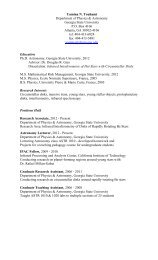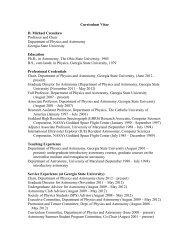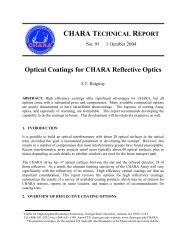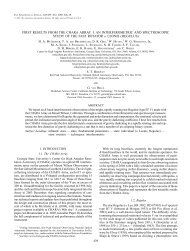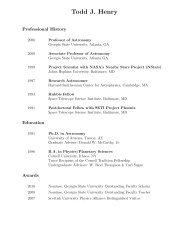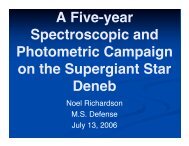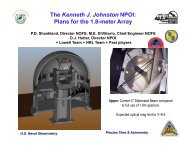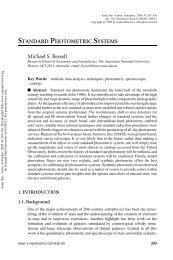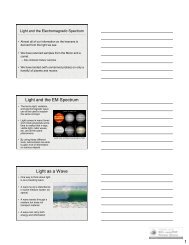ruling out possible secondary stars to exoplanet host stars using the ...
ruling out possible secondary stars to exoplanet host stars using the ...
ruling out possible secondary stars to exoplanet host stars using the ...
- No tags were found...
Create successful ePaper yourself
Turn your PDF publications into a flip-book with our unique Google optimized e-Paper software.
168 BAINES ET AL. Vol. 140that realistically models instrumental and atmospheric noises,as well as observations of pairs of known brightness contrasts,indicate that <strong>the</strong> Array is sensitive <strong>to</strong> a magnitude difference in<strong>the</strong> K band (ΔK) of 3.0. Therefore, if a second star is presentand is not more than ∼3.0 mag fainter than <strong>the</strong> <strong>host</strong> star, <strong>the</strong>effects of <strong>the</strong> second star will be seen in <strong>the</strong> interferometric data.It should be noted that a limiting magnitude difference in <strong>the</strong> Kband (ΔK) of 3.0 is a lower limit, as <strong>the</strong> true ΔK also dependson <strong>the</strong> absolute brightness of <strong>the</strong> two <strong>stars</strong> and could be slightlyhigher for some systems.This technique of <strong>using</strong> interferometric observations <strong>to</strong> eliminate<strong>the</strong> possibility of certain types of <strong>secondary</strong> <strong>stars</strong> was employed<strong>to</strong> examine <strong>the</strong> <strong>exoplanet</strong> <strong>host</strong> star 51 Peg (HD 217014)by Boden et al. (1998), whose analysis of Palomar Testbed Interferometerdata supported a single-star model for that star. Theyfit single-star and binary-star models <strong>to</strong> <strong>the</strong> data and found thatany <strong>possible</strong> unseen stellar companion would have <strong>to</strong> have aK-magnitude fainter than 7.30 and a mass of less than 0.22 M ⊙ .Here, we describe our interferometric observations, ourmethod for choosing calibra<strong>to</strong>r <strong>stars</strong>, and define <strong>the</strong> role interferometricresolution plays in Section 2. In Section 3, wediscuss how <strong>the</strong> angular diameter fit residuals <strong>to</strong> calibrated visibilitiescan help us eliminate certain types of <strong>secondary</strong> <strong>stars</strong>;and Section 4 explores <strong>the</strong> implications of <strong>the</strong> observations. Thispaper is follow-on work <strong>to</strong> an earlier study (Baines et al. 2008b).2. INTERFEROMETRIC OBSERVATIONSAll observations were obtained <strong>using</strong> <strong>the</strong> Center for HighAngular Resolution Astronomy (CHARA) Array, a six-elemen<strong>to</strong>ptical/infrared interferometric array located on Mount Wilson,CA (ten Brummelaar et al. 2005). We used <strong>the</strong> pupil-plane“CHARA Classic” beam combiner in <strong>the</strong> K ′ band (2.133 μmcenter with a 0.349 μm width), while visible wavelengths(470–800 nm) were used for tracking and tip/tilt corrections.The observing procedure and data reduction process employedhere are described in McAlister et al. (2005). The observablequantity from an interferometer is <strong>the</strong> fringe contrast or “visibility”of <strong>the</strong> observed target, and each data set consists ofapproximately 200 scans across <strong>the</strong> fringe.Our target list was selected from <strong>the</strong> complete <strong>exoplanet</strong> listby <strong>using</strong> declination limits and magnitude constraints: north of−10 ◦ declination, brighter than V = +10 in order for <strong>the</strong> tip/tilt system <strong>to</strong> lock on<strong>to</strong> <strong>the</strong> star, and brighter than K = +6.5for reliable fringe detection with a sufficiently high signal-<strong>to</strong>noiseratio. We obtained data on <strong>the</strong> 20 <strong>exoplanet</strong> <strong>host</strong> <strong>stars</strong>between 2005 Oc<strong>to</strong>ber and 2008 September. The observationswere taken <strong>using</strong> mostly <strong>the</strong> longest baseline available on <strong>the</strong>CHARA Array (331 m), though 156 m and 249 m baselineswere also used.Reliable calibra<strong>to</strong>rs <strong>stars</strong> are critical in interferometric observations,acting as <strong>the</strong> standard against which <strong>the</strong> sciencetarget is measured, and <strong>the</strong> ideal calibra<strong>to</strong>r is a single, spherical,non-variable star. Our observing pattern was calibra<strong>to</strong>r-targetcalibra<strong>to</strong>rso that every target was bracketed by calibra<strong>to</strong>r observationsmade as close in time as <strong>possible</strong>; <strong>the</strong>refore, “fivebracketed observations” denote five target and six calibra<strong>to</strong>rdata sets. The target–calibra<strong>to</strong>r (T–C) distances ranged from 1 ◦<strong>to</strong> 9 ◦ and 13 calibra<strong>to</strong>rs were within 4 ◦ of <strong>the</strong>ir target <strong>stars</strong>.This allowed us <strong>to</strong> observe <strong>the</strong> <strong>stars</strong> as close <strong>to</strong>ge<strong>the</strong>r in timeas <strong>possible</strong>, usually on <strong>the</strong> order of 3–5 minutes between <strong>the</strong>two, <strong>the</strong>refore, reducing <strong>the</strong> effects of changing seeing conditionsas much as <strong>possible</strong>. Table 1 lists <strong>the</strong> <strong>exoplanet</strong> <strong>host</strong> <strong>stars</strong>observed, <strong>the</strong>ir calibra<strong>to</strong>rs, <strong>the</strong> dates of <strong>the</strong> observations, <strong>the</strong>Table 1Observing LogTarget Calibra<strong>to</strong>r Baseline Date No. T–C SepHD HD (max. length) (UT) Obs (deg)10697 10477 S1–E1 (331 m) 2005 Oct 23 4 42007 Sep 14 413189 11007 S1–E1 (331 m) 2005 Dec 12 4 42006 Aug 14 432518 31675 S1–E1 (331 m) 2007 Nov 14 9 345410 46590 S1–E1 (331 m) 2008 Sep 11 5 250554 49736 S1–E1 (331 m) 2005 Dec 12 5 273108 69548 E2–W2 (156 m) 2008 May 9 5 7136726 145454 E2–W2 (156 m) 2008 May 9 6 6139357 132254 S1–E1 (331 m) 2007 Sep 14 4 7145675 151044 S1–E1 (331 m) 2006 Aug 12 6 8154345 151044 S1–E1 (331 m) 2008 Sep 10 7 4164922 159139 S1–E1 (331 m) 2008 Aug 11 5 7167042 161693 S1–E1 (331 m) 2007 Sep 15 8 4170693 172569 W1–S2 (249 m) 2007 Sep 3 4 1185269 184381 S1–E1 (331 m) 2008 Jul 18 15 32008 Jul 20 5188310 182101 S1–E1 (331 m) 2008 Sep 8 8 8199665 194012 S1–E1 (331 m) 2008 Sep 8 10 9210702 210074 S1–E1 (331 m) 2008 Sep 8 4 4217107 217131 S1–E1 (331 m) 2008 Sep 8 5 1221345 222451 S1–E1 (331 m) 2008 Sep 11 5 3222404 219485 S1–E1 (331 m) 2008 Sep 11 7 4Notes. The three arms of <strong>the</strong> Array are denoted by <strong>the</strong>ir cardinal directions: “S”is s<strong>out</strong>h, “E” is east, and “W” is west. Each arm bears two telescopes, numbered“1” for <strong>the</strong> telescope far<strong>the</strong>st from <strong>the</strong> beam combining labora<strong>to</strong>ry and “2” for<strong>the</strong> telescope closer <strong>to</strong> <strong>the</strong> lab.baseline used, <strong>the</strong> number of observations obtained, and <strong>the</strong>T–C distance.In order <strong>to</strong> check for excess emission that could indicate a lowmassstellar companion or circumstellar disk, we fitted spectralenergy distributions (SEDs) based on published UBVRIJHKpho<strong>to</strong>metric values for each calibra<strong>to</strong>r star. Limb-darkeneddiameters were calculated <strong>using</strong> Kurucz model atmospheres 5based on effective temperature and gravity values obtained from<strong>the</strong> literature. The models were <strong>the</strong>n fit <strong>to</strong> observed pho<strong>to</strong>metricvalues also from <strong>the</strong> literature after converting magnitudes <strong>to</strong>fluxes <strong>using</strong> Colina et al. (1996) forUBVRI values and Cohenet al. (2003) forJHK values.Many of <strong>the</strong> calibra<strong>to</strong>r <strong>stars</strong> chosen here had been used ascomparison or calibra<strong>to</strong>r <strong>stars</strong> in o<strong>the</strong>r studies, or speckle studiesdid not find companions (see Table 2). For those calibra<strong>to</strong>r <strong>stars</strong>that had not been previously observed, <strong>the</strong>ir SED fits showed noexcess flux that could indicate a stellar companion that would<strong>the</strong>n contaminate our interferometric observations.Our ability <strong>to</strong> detect stellar companions depends on two mainfac<strong>to</strong>rs. The first is <strong>the</strong> precision of our visibility measurements.The higher <strong>the</strong> precision, <strong>the</strong> higher our sensitivity <strong>to</strong> findinga <strong>secondary</strong> companion. The second fac<strong>to</strong>r is whe<strong>the</strong>r <strong>the</strong>measured angular diameters or potential primary–<strong>secondary</strong>separation would be resolved in our data. The resolution of aninterferometer depends on <strong>the</strong> wavelength used and <strong>the</strong> distancebetween <strong>the</strong> telescopes, o<strong>the</strong>rwise known as <strong>the</strong> baseline. A staris considered unresolved if its visibility is ∼ =1 and is completelyresolved when its visibilities drop <strong>to</strong> zero. Differently sized <strong>stars</strong>will be resolved at different baselines (see Figure 1).5 See http://kurucz.cfa.harvard.edu.



